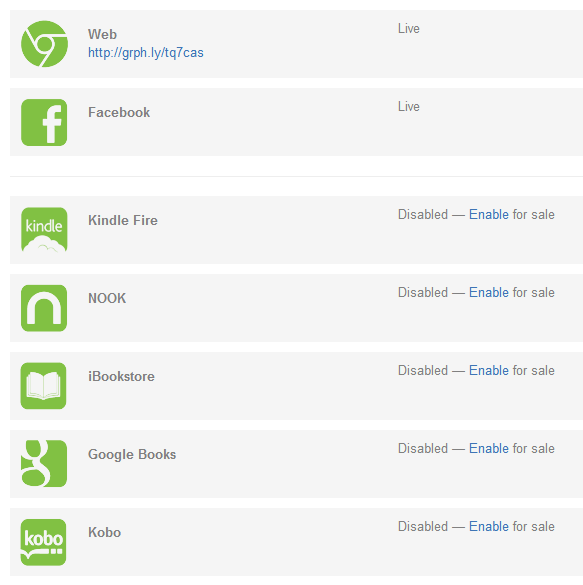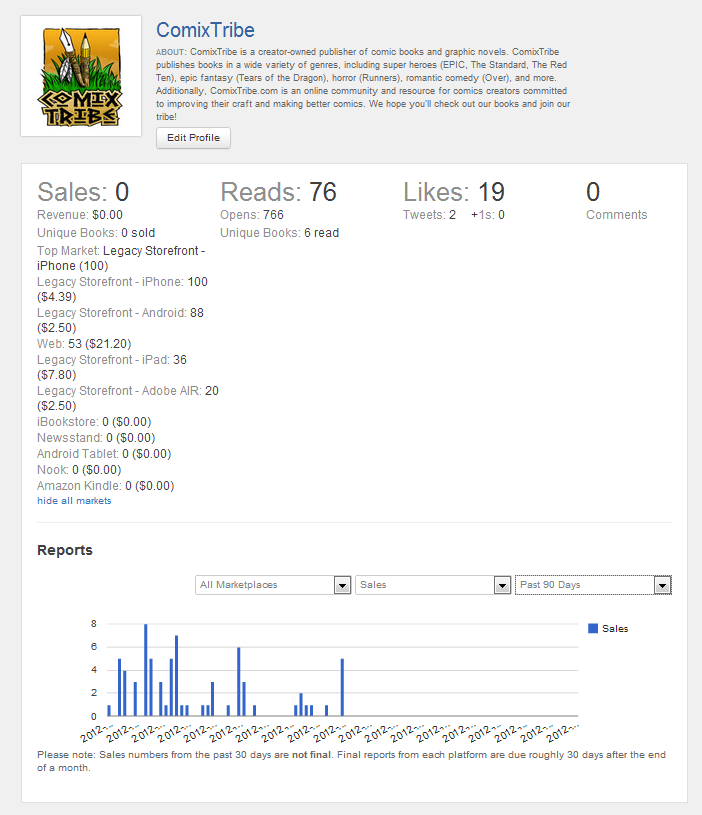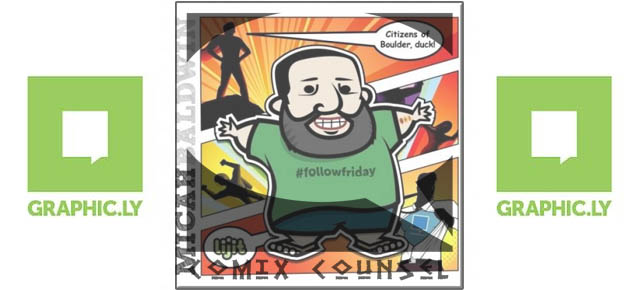Talking Graphic.ly with Micah Baldwin
In last week’s ComixCounsel, I shared my thoughts on Graphic.ly, one of the major players in digital comic book distribution’s big company shake-up. Shortly after my post, Graphic.ly CEO Micah Baldwin sent out a letter to publishers clarifying some misconceptions about their change. On April 11, Micah wrote:
Why did you retire the Graphicly Apps?
We only retired the Graphicly BRANDED iOS and Android Apps. not the publisher branded NEWSSTAND or COLLECTION (NOOK/Amazon) apps. Books are still being sold on the Graphicly web site and on Facebook.
There are three reasons for this decision:
1) Our driving principle has always been: “Great story deserves to be seen.” As a store, we can only promote books that make money. Not necessarily the best stories. A great book could be buried because its unknown to the comic collecting public (which is estimated to number around 300,000). The argument is that people coming to buy a Spiderman, Superman, etc book will see the indie book and buy it is false. Doesn’t work at your Local Comic Store. Doesn’t work in some random app either.
Being a store makes it impossible for great story to be seen. Only great selling books get seen.
2) By supporting publishers ability to distribute their content to all marketplaces, we are helping publishers get access to more than 1 BILLION devices.
Lets say that Kindle, NOOK and iBooks is installed on just 10% of all devices (its probably closer to 50-75%). That’s 100 million installs! Does it matter? Yes. Some publishers are seeing sales in excess of 10-20X in ebook stores than they are seeing in the BRANDED apps. Some much, much more.
3) Books belong in the bookstore. This opens up a whole new world in a whole new way for publishers and creators.
Comic-specific apps only attract comic fans. Book stores attract book fans, who love story and are willing to try new books. In addition, they are used to paying higher per unit prices and testing out more books. eBook sales are skyrocketing, and books purchased per person is also growing. All indications are that comics purchases and purchases per person are flat or declining.
The biggest reason? Because its good for you.
What does that mean for my books in Graphicly?
They are still for sale. Nothing changes other than the branded apps have been retired.In fact, most of you missed the announcement, but most of your back catalog that was in the Graphicly Marketplace (as of January 1) was put in iBooks for free.
You now have access to your Dashboard. Moving forward, you can upload your content here and ready it for distribution. There is a new term of service that covers the usage of the publishing platform, and as of May 1, we will no longer convert your content at no cost, but submitting to the Graphicly Marketplace will always be free. Pricing here(volume discounts available).
Why is this good?
The bottom line is that you will be in front of more people, in more marketplaces, in the bookstore where you should be, rather than just in some random app. In addition, you will own your brand, and be able to directly connect to your fans and build that fan base. Plus, you keep more money from your sales.
Micah also commented on my post last week, volunteering to wave the transaction fee on the OVER graphic novel as a test case for the new platform, and we set up a call to discuss the new Graphic.ly positioning, the reasons behind the change, and to answer questions fellow ComixTribers have about the new service. Prior to Micah’s comment, I had started doing a fundraising drive by selling digital and physical copies of OVER at a reduced price to see if there was enough interest here to test it out. As a response to Graphic.ly’s generosity, I refunded all of the money sent from ComixTribe readers, and let them keep the copies of OVER as a token of thanks.
Last Thursday, I talked to Micah for about 45 minutes, and here are eight takeaways from the discussion.
1.) One of the major reasons for the change in strategy was that, after several years of trying, Graphic.ly decided it simply did not want to be a digital marketplace. This is why they are retiring the Graphic.ly branded app. Graphic.ly surveyed the competitive landscape of sellers of digital books and saw they were fighting a losing battle. In the comics world, we’ve largely focused on the players in digital comics, the Comixologies, Iverses, and Graphic.lys. But I got the sense from talking to Micah that the company was less concerned with the Comixologies, and more with the iBooks, Kindle and Nook stores of the world. Readers buy from companies they know and trust, and Apple and Amazon are far more likely to convert sales than a small app like Graphic.ly.
“The reality is that we felt publishers would have a better chance selling books in iBooks and through the Kindle store than through our marketplace.” To that point, there are 315 million iOS devices out there, and most of them come pre-loaded with iBooks, but a tiny, tiny fraction have the Graphic.ly app installed.
 2.) Still, Graphic.ly is keeping their marketplace going on their website and in Facebook. I wondered, why not get out of the digital retail space entirely? Micah was candid that they are keeping their website and Facebook channels open for two reasons.
2.) Still, Graphic.ly is keeping their marketplace going on their website and in Facebook. I wondered, why not get out of the digital retail space entirely? Micah was candid that they are keeping their website and Facebook channels open for two reasons.
First, upkeep of the website is relatively simple, and they needed a way to have people with collections to maintain access to them.
Second, they wanted a free option for new publishers. As it stands right now, publishers can use their conversion tools, upload their books and then publish to the web or Facebook for free, where publishing to iBooks, Kindle, Nook, etc. will cost them. Again, this makes sense. The “Freemium” model of service has been one of the most successful models of service on the web in the last decade, and having that “Enable for Sale” button staring you in the face every time you go to your dashboard is tempting.
3.) Graphic.ly wants to support publishers, but is agnostic about how they release their content. I asked Micah whether he felt trades and original graphic novels were better suited to the digital bookstore channels they were now favoring. He felt that there is a strong opportunity now for graphic novels in those channels. In fact, because of the challenges of converting graphic intensive content to digital and that content only now being well supported on new generation Kindles and Nooks, the GN selection on iBooks, Kindle, etc. is one area that is not super-saturated right now. Yes, Walking Dead trades might dominate, but Micah felt there is opportunity for independent titles to gain some traction there now.
Whether trades/graphic novels make more sense than individual issues is a decision Graphic.ly wants entirely left up to the publisher. Digital Book Stores have been able to support higher price points than comics apps, which might make $2.99-$9.99 trades possible in those marketplaces. Micah also said they have been seeing the iBook subscription services doing well for serialized content, and could see publishers that release content on a regular basis do well there. He also mentioned that they have considered bulk pricing for publishers, so I’m sure publisher of a monthly comic could negotiate better terms than the $150.00 per “floppy.” (Heh, how long will we still be calling them floppies?)
4.) When I mentioned our sales performance last year, Micah said he wasn’t surprised. “Unfortunately, 90-95% percent of our publishers were not selling books,” Micah admitted. “Big name stuff was all that was selling, and the fallacy was that having an indie book on the digital shelves next to Spider-man would result in sales. It doesn’t.” Micah also attributed a lot of that to the collector’s mentality of comic fans…comic fans largely know what they want to read before they show up to store. “Graphic.ly could have 20,000 comic books can you imagine walking into a comic shop with 20,000 books on the racks? You’re books would never sell.”
Micah sees an opportunity in the iBooks and Kindle spaces, as there seems to be a willingness to try more stuff there. Buying decisions are based on covers and synopses, and Kindle and iBooks have invested millions in a large, ongoing staff focused solely on optimizing the buying experience. (Something Graphic.ly could never hope to compete with.) Graphic.ly felt they were better off getting out of the middle of the transaction between pubs and readers, and instead support creators to serve readers directly.

Metrics provided by Graphic.ly. As you can see, we haven't exactly been setting the world on fire saleswise.
5.) Graphic.ly wasn’t willing to shoulder all of the blame for poor digital sales through their channel, however. Micah felt that most of the publishers who submitted work to Graphic.ly and expected the books to sell naturally were very disappointed. They did not see a ton of publisher effort put into driving sales to their platform. Part of the reason they’re sticking with the $150 fee is that they want pubs to feel like they have some skin in the game. The thought being, perhaps if creators are investing in digital (even just $150), they’ll work harder to get the word out about their books. “At the end of the day $150 is not that big and investment to get into all of those channels. It’s cheaper than a con, and the potential is much greater,” said Baldwin.
6.) One thing that many publishers (including this one) missed, was that on Jan 1, Graphic.ly put all of their current publishers’ work on iBooks for free. After talking to Micah, I checked and found a selection of ComixTribe books on iBooks, some free, some paid, for the same prices as they were being sold on the Graphic.ly app.
While this was a nice service, checking my stats, I see that in the last four months, just being on iBooks resulted in a grand total of ZERO sales for ComixTribe. So, again, it’s important to note that simply being in these channels is NOT enough to get you sales.
I also noticed the transition job done for Tears of the Dragon, my horizontally formatted book, needs some SERIOUS debugging for iBooks, so creators will still need to pay attention to how their books end up on those platforms. The fact that publishers do not currently have a way of checking out their book on those platforms without buying it is a problem Micah and his team are trying to find a workaround for.
7.) Look for more services and information coming from Graphic.ly, including a focus on sharing some best practices on how to sell and market digital goods. Their pricing structure is a first start, but they seem to have some flexibility and will be looking at bulk discounts and other approaches.
8.) Graphic.ly and Comixology, though always pegged as competitors, from the start had a much different business model. “There’s a reason Comixology only has 30 publishers and haven’t added many independent ones in the last few years. Most of the independent books on their were legacy, before they signed deals with Marvel and DC. Comixology is very much a store, and so the books they carry must sell.” Graphic.ly, on the other hand, wants to make their service available to all publishers to get their stories distributed. Shutting down their branded app focus will allow them to do just that.
Obviously, the digital landscape is one that’s changing quickly. I came away from my conversation with Micah pretty much convinced that Graphic.ly was making a smart business decision, and was impressed with the frankness and transparency at which they were making the change. Going forward, ComixTribe will likely continue doing business with them, but if we’re going to invest money into digital, we’re going to have to have a much stronger and comprehensive sales strategy. Digital Comics Manager Yannick Morin and I will have a lot to talk about…
Related Posts:
Category: Comix Counsel


















Keep it coming, Tyler. This is all very informative. I was a little distraught once I heard the Graphicly news (like a lot of people,) but more and more I’m starting to grasp what could possibly be a boon to everyone and the industry as a whole. Plus, what Micah has said about marketing is something that we all need to hear. Just getting our books out there isn’t enough. “If you build it, they will come” isn’t necessarily true, you still have to “tell them” it’s there. A good friend of mine said, “You paid all this money creating the book, you might as well market the thing.”
You got it, Josh. Thanks for reading, and I’ll keep on sharing the journey.